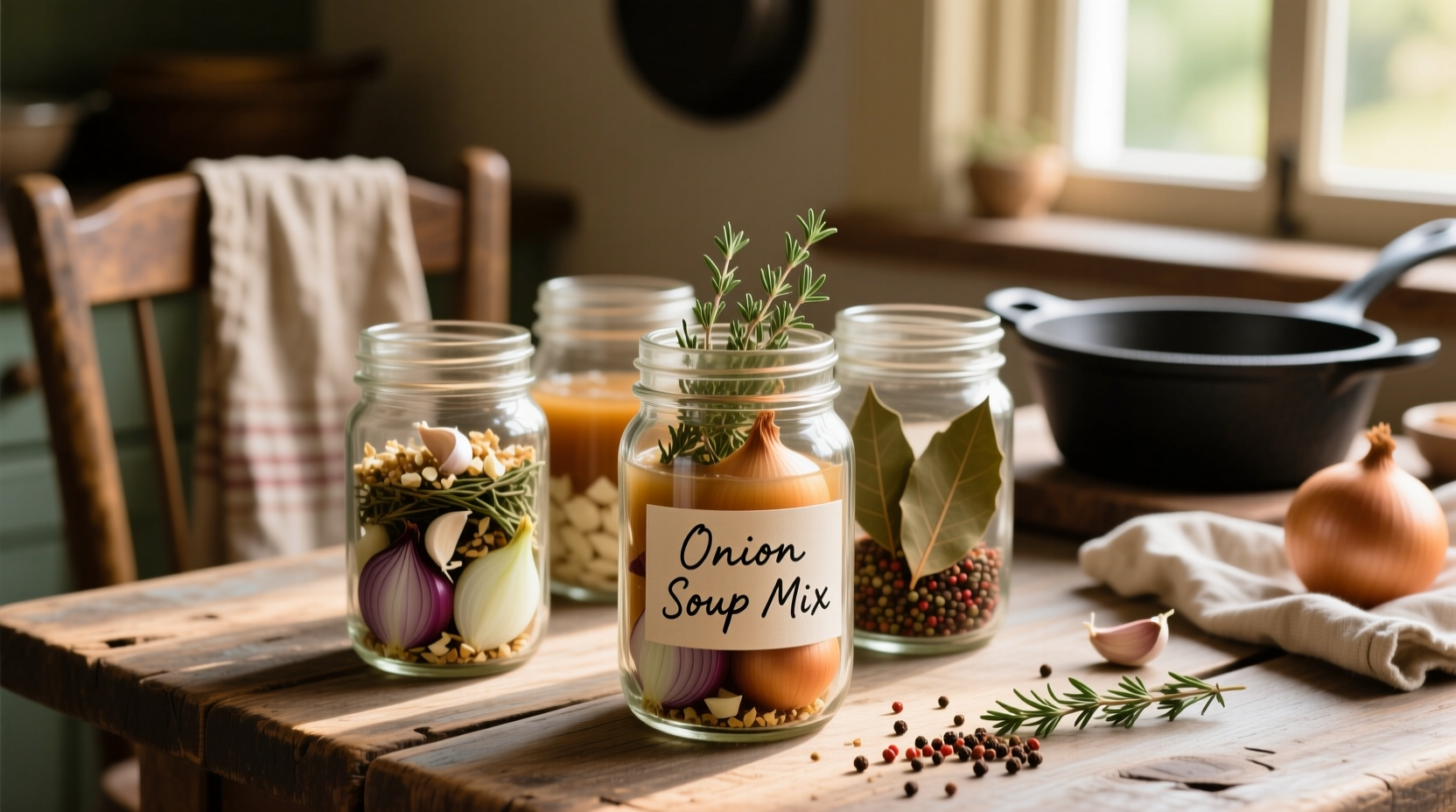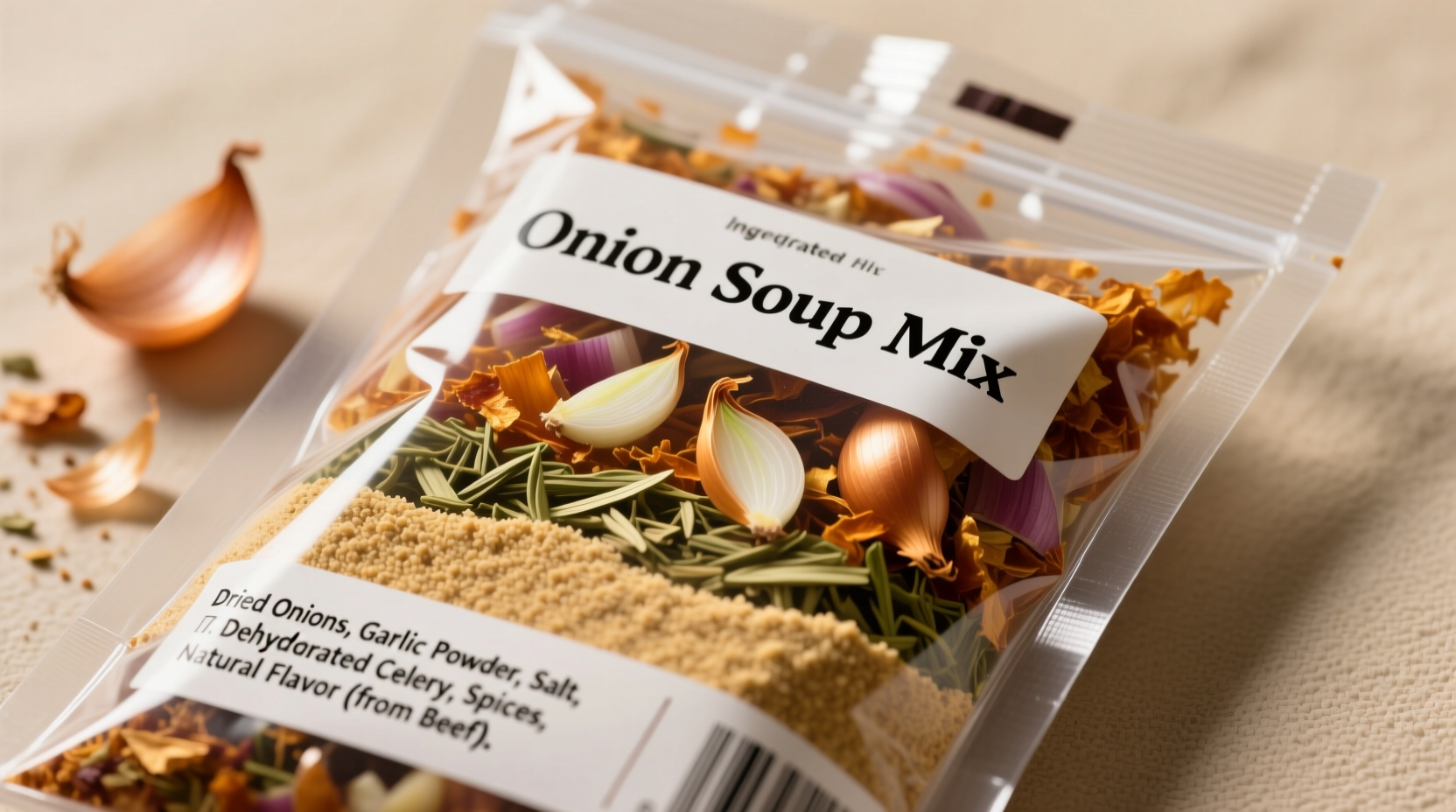What Exactly Makes Up That Familiar Flavor?
When you reach for that envelope of onion soup mix at the grocery store, you're grabbing a carefully engineered blend designed to deliver consistent flavor with minimal effort. Understanding what's inside helps you make informed choices whether you're following a classic recipe or adapting it to your dietary needs.
Breaking Down the Standard Ingredients
Commercial onion soup mixes follow a remarkably consistent formula across most major brands. Let's examine each component and its purpose in creating that distinctive flavor profile:
Dehydrated Onions: The Foundation
Accounting for 40-60% of the mix by weight, dehydrated onions form the base. Manufacturers typically use a combination of onion varieties processed through:
- Slice dehydration (retains more natural onion flavor)
- Flake processing (provides quicker dissolution)
- Powder form (for more intense onion flavor)
Salt and Flavor Enhancers
Salt typically comprises 15-25% of the mix, serving both as a flavor enhancer and preservative. Many brands supplement this with:
- Monosodium glutamate (MSG) - present in about 60% of commercial mixes according to USDA food composition data
- Yeast extract - a natural glutamate source used in "no added MSG" formulations
- Disodium inosinate and guanylate - often paired with MSG for flavor synergy
| Common Ingredient | Typical Percentage | Primary Function |
|---|---|---|
| Dehydrated onions | 40-60% | Base flavor and aroma |
| Salt | 15-25% | Flavor enhancement and preservation |
| Sugar | 5-10% | Balances acidity and enhances browning |
| Cornstarch | 3-8% | Thickening agent |
| Beef fat or yeast extract | 2-5% | Umami foundation |
How Brands Differ in Their Formulations
While the basic formula remains consistent, notable variations exist between brands and product lines:
Premium vs. Standard Versions
Higher-end mixes often feature:
- Increased onion content (up to 70%)
- Natural flavorings instead of artificial ones
- Reduced sodium options (typically 30-40% less salt)
- Organic certification and non-GMO ingredients
Dietary-Specific Formulations
Many manufacturers now offer specialized versions addressing common dietary concerns:
- Gluten-free options (replacing wheat-based thickeners)
- Vegan formulations (substituting beef fat with vegetable oils)
- Low-sodium varieties (using potassium chloride blends)
- "Clean label" versions without artificial preservatives
Creating Your Own Homemade Alternative
When you make your own onion soup mix, you control exactly what goes in it. This basic recipe yields approximately one envelope's worth:
Simple Homemade Onion Soup Mix
- ¼ cup dehydrated onion flakes
- 2 tablespoons beef bouillon powder (or vegetable bouillon for vegan option)
- 1 tablespoon cornstarch or arrowroot powder
- 1 teaspoon garlic powder
- 1 teaspoon sugar
- ½ teaspoon black pepper
- ½ teaspoon paprika
- ¼ teaspoon thyme
- Salt to taste (start with ½ teaspoon)
Mix all ingredients thoroughly and store in an airtight container. This blend works perfectly for French onion soup, meatloaf, or as a seasoning for roasted vegetables. The USDA FoodData Central confirms that homemade versions typically contain 30-50% less sodium than commercial alternatives.

Practical Usage Tips You Need to Know
Understanding how to maximize onion soup mix in your cooking can transform ordinary dishes:
For Perfect French Onion Soup
While traditional French onion soup starts with caramelized onions, adding one envelope of soup mix to 4 cups of broth enhances depth. Professional chefs recommend:
- Using reduced-sodium broth when incorporating the mix
- Adding the mix after caramelizing onions but before deglazing with wine
- Finishing with a splash of sherry for authentic Parisian bistro flavor
Beyond Soup: Creative Applications
Modern home cooks have discovered numerous innovative uses:
- Meatloaf secret: Replace breadcrumbs with reconstituted onion soup mix for added moisture and flavor
- Instant gravy: Whisk one envelope into 2 cups of pan drippings
- Marinade base: Combine with olive oil and vinegar for steak or chicken
- Vegetable boost: Stir into mashed potatoes or roasted root vegetables
Addressing Common Health and Dietary Concerns
Many home cooks have valid questions about the ingredients in commercial onion soup mixes:
Sodium Content Awareness
A single envelope typically contains 800-1,200mg of sodium, which represents 35-50% of the recommended daily limit. The American Heart Association suggests using half an envelope and supplementing with additional fresh onions and herbs to reduce sodium while maintaining flavor.
MSG and Flavor Enhancer Facts
Despite common misconceptions, the FDA classifies MSG as generally recognized as safe (GRAS). Research published in the Journal of Food Science indicates that moderate MSG consumption doesn't cause adverse reactions in most people. If you're sensitive, look for brands using yeast extract instead.
Allergen Information You Should Know
Most commercial onion soup mixes contain:
- Wheat (in the form of modified food starch)
- Soy (often in the form of soybean oil)
- Milk derivatives (in some creamy versions)
Always check labels carefully if you have food sensitivities, as formulations can change without notice.
When to Choose Commercial vs. Homemade
Both options have their place in modern cooking. Consider these factors when deciding:
Situations Favoring Commercial Mix
- When consistent flavor is critical for special occasions
- For quick weeknight meals when time is limited
- When specific recipe instructions call for a particular brand
When Homemade Shines
- For dietary restrictions requiring specific ingredient control
- When cooking for guests with known sensitivities
- For preserving during seasonal onion abundance
- When teaching children about ingredient transparency











 浙公网安备
33010002000092号
浙公网安备
33010002000092号 浙B2-20120091-4
浙B2-20120091-4